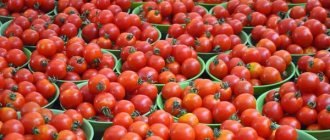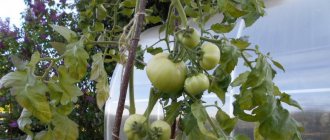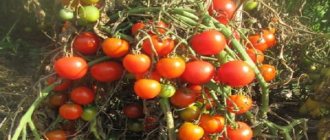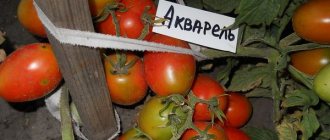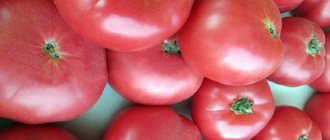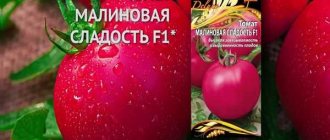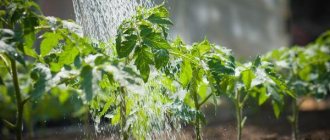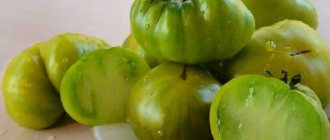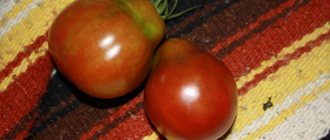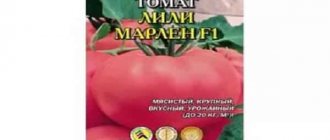Description of the variety
Fruit:
- Flat-rounded in shape, have pronounced ribbing near the stalk;
- Those that have not reached varietal maturity are green in color; as they ripen, they become reddish-brown with a tint of chocolate color;
- With a thin but fairly dense skin, which serves as reliable protection against cracking;
- With moderately juicy, sugary, not watery pulp, with a small amount of seeds;
- With a pleasant, richly sweet taste;
- High content of sugars and lycopene;
- Large sizes.
Average weight is from 250 to 300 grams.
Bushes:
- Semi-determinate, moderately spreading, medium foliage;
- Height varies from 120 to 150 cm;
- The leaves are medium sized, dark green in color.
Tomato Banana legs. Another masterpiece from the Partner: created to surprise you
How many types of tomatoes do we plant? Ten, twenty? Are we planting just to eat or are we looking for some cool new crops for the future? I consider myself to be in the second group of summer residents. Therefore, I have many favorite varieties, each good in its own way. There are disappointments and delights. But today it’s only about delight. I present to your attention the Banana Legs tomato:
Banana legs Back in 2021, I wanted this wonderful new product, but I couldn’t find the seeds for sale. This year I saw banana legs everywhere.))
Banana legs I planted my seeds on February 22 in half-liter cups. The plants were comfortable in them before being planted in the greenhouse. This year I planted 2 plants of all varieties - not a lot, but I’m looking for the best ones for myself, so I’ll do a little bit of everything. Banana legs are a distinctly indeterminate tomato. I made a little mistake with the landing place: I planted it in the outer row, but it should have been in the center. The bushes are very tall, already about 170 cm, and continue to grow upward.
Banana legs are stretchy, but I tied them up better, I hope they like it. She formed bushes into 2 main stems and two more from them. The only thing I don't like is the foliage. It is carved and drooping, and when tied, it clings to everything. As the plants grow and harvest, I remove the lower leaves. There is enough food for everyone. I fed it with kuryak the other day, like all the other tomatoes, before that with ash for watering. Well, I add phytosporin to every watering, this is the second year I’ve been doing this - I’m satisfied. For late blight, I additionally spray with Ordan; that year there was no late blight until November, then the bushes were removed.
Banana legs Let's look at the beauty up close. Banana legs are plum-shaped tomatoes, with an elongated, crooked shape. Very beautiful yellow fruits with pearlescent stripes of different shades - lighter and darker. At the tip of each tomato there is a little nose.
Banana legs I have deja vu with tomatoes from SEARCH, but there is a difference in color and size: Banana legs tomatoes are exactly like the picture.
Banana legs Fruits are from 8 cm in length.
Banana legs The weight of not the largest tomato is about 60 grams.
Banana legs Look at this cut, the tomato has two chambers, a very ripe fruit will be juicy:
Banana legs A longitudinal section shows that the walls are thick. You can stuff tomatoes using this cut. The pulp separates perfectly. Neutral in taste, for lovers of a not rich tomato taste, just for me. The skin is thick and will go great in canning, especially when mixed with cream of a contrasting color.
Banana Legs I really liked the Banana Legs tomato. It is productive, even on my modest two bushes this is noticeable. They taste great, and yes, they will be on the list of tomatoes I will plant next year.
Banana legs Thank you for your attention!
Tomato: advantages and disadvantages
The Paul Robeson tomato variety has the following positive qualities:
- Large fruit;
- Excellent taste characteristics;
- High content of sugars, amino acids, lycopene;
- Ability for long-term storage;
- Immunity to characteristic tomato diseases;
- Possibility of transportation;
- Long fruiting period;
- Commercial appearance of the fruit.
Among the disadvantages of the variety are:
- The need to form a bush;
- Increased demands on applied fertilizers and irrigation regime.
Growing tomatoes
To cultivate the Paul Robeson tomato variety, the seedling method is used.
How to prepare seeds?
To ensure 100% germination of the seed material, it is soaked in a growth stimulator for 10-12 hours before sowing.
Sowing seed material
Description:
- Sowing of seed material for seedlings begins in the second half of March;
- Give preference to light soil, which contains garden or turf soil and humus in equal proportions. It is also recommended to add river sand mixed with wood ash to the soil mixture;
- Sow the seeds in special containers, pre-disinfected, deepening them to about 2 cm;
- To speed up seed germination, the temperature should be from +23 to +25 degrees. With the appearance of the first shoots, the temperature regime is lowered, and the containers with seedlings are moved to a well-lit windowsill;
- Water moderately with warm water. For watering, use a watering can or spray bottle;
- As soon as two full-fledged leaves are formed, they begin to pick the seedlings into separate containers. After the planting procedure, they are fed using a complete complex fertilizer.
Rules for planting seedlings
Description:
- They begin to transplant seedlings into a greenhouse structure in the second half of May;
- The soil is pre-prepared, loosened and humus is added;
- Each planting hole is filled with a mixture of superphosphate and potassium sulfate;
- No more than three tomato bushes are planted per 1 m2.
How to grow
To start growing the Paul Robeson variety, you do not need to have any specific knowledge or skills. Tomatoes will do well both in a greenhouse and in open ground. But in order to get maximum yield, it is still necessary to take care of a place in which a particular variety can develop freely. For the Paul Robeson variety, the best option would be a greenhouse.
Tomato bushes need staking to a support. It is recommended to start sowing in mid-March. Seedlings need to be planted at a depth of at least 2 cm. To ensure that growth is guaranteed, experts recommend treating the seeds with a treatment that will stimulate their growth. Starting from mid-May, seedlings must be moved to moist soil.
Tomatoes of this variety ripen on average in 4 months. To prevent plants from being subject to late blight (the most common cause of death of tomatoes), it is necessary to water them moderately.
Note! Watering tomato bushes with cold water is prohibited - this can lead to the death of the plant. It is recommended to periodically fertilize tomatoes.
To do this, it is necessary to use a mixture of potassium sulfate and superphosphate. There should not be more than 3 bushes on one square meter. If you plant more, it will negatively affect the entire seedling, to the point that it may die
It is recommended to periodically fertilize tomatoes. To do this, it is necessary to use a mixture of potassium sulfate and superphosphate. There should not be more than 3 bushes on one square meter. If you plant more, it will negatively affect the entire seedling, to the point that it may die.
It is necessary to form bushes into 2 stems. Experts recommend leaving 4 to 5 tassels, because during maturation it will be difficult for the plant to withstand a large number of tassels. It is also necessary to carefully pick the bushes. Once every 5 days you need to thin out the leaves on the plants.
Among other things, tomatoes of this variety are resistant to all kinds of diseases. You just need to carefully monitor the plant for late blight. If the plant is already infected, then it will not be possible to save the seedlings. To protect the plant from fungal and viral diseases, it is necessary to carry out preventive measures and treat tomatoes with special preparations.
Bush care
After planting, tomato bushes need the following measures:
- Watering. It is not recommended to allow the soil layer to dry out. Water moderately with warm water. The use of cold water inhibits the growth of the plant and also provokes a massive discharge of the ovaries;
- To obtain maximum yield, the bush is formed into two stems. For this purpose, all lateral stepsons growing above the fifth hand are cut off. To obtain larger fruits, only 3-4 flowers are left on the cluster;
- To improve the air exchange of the plant, all lower leaves should be torn off every 5-7 days;
- Throughout the season, two or three feedings are carried out. During the flowering period, they are fed with complete mineral fertilizers enriched with potassium, calcium, and microelements: iron, phosphorus. During fruit formation, tomatoes need magnesium sulfate and a full range of microelements. In the second half of the growing season, it is not recommended to get carried away with nitrogen-containing fertilizers. To increase the yield, feed with magnesium sulfate during the formation of ovaries;
Tomato bushes should be provided with reliable support to prevent branches from breaking off under the weight of their own fruits.
Paul Robson tomato
Opinions about it are as contradictory as the color of its sides - from red to dark brown, almost black.
It can be recognized by its chocolate-brown skin with a glossy gloss, with a green spot near the fruit - the vine-shaped tomato Paul Robeson is known to many connoisseurs of tomato growers.
What beginners don’t know, what is worth knowing about chokeberry - detailed characteristics, disadvantages and advantages, subtleties of cultivation.
About the black chokeberry variety, opinions about which vary greatly. What did not please gardeners, what pleased them.
Seed material is distributed by the Biotechnika agro-group, St. Petersburg. Known in the European Union and the USA as the Paul Robeson variety. At Caramel TomatoFest, an international tasting exhibition, it was recognized as the best in terms of taste and aroma.
Description, characteristics
Russian selection, distributed by the Biotechnika agro-group, St. Petersburg (the selection is indicated as amateur). It is grown in open and closed ground, good for hotbeds and hothouses, and feels at ease in country garden beds.
In the photo there is a Paul Robeson tomato, a small specimen - the color is not conveyed quite correctly, in real life it is browner
Medium ripening period, sometimes referred to as mid-late.
- The growing season is 115-120 days. Salad type, used fresh in cooking.
- Indeterminate (semi-indeterminate) type - self-limiting in growth after the 7th hand, requires gartering and pinching. The bush is tall, medium spreading, medium leafy.
- The leaves are dark green, medium. The fruits are flat-rounded, somewhat ribbed at the stalk, collected in clusters of 4-5 pieces. Fruit weight ranges from 70-100 g to 250-300 g - depending on the method of formation, soil fertility, and fertilizing. The shape is round, the largest specimens are slightly ribbed, the small ones are smooth and even.
- As it ripens, the skin changes color from green to brown-red, red-brown, with a chocolate tint, and the spot on the fruit stem becomes colored. The peel is thin, but strong, preventing neat, dense tomatoes from cracking. The taste is rich, pleasant, multifaceted. The pulp is fleshy, low-seeded, sugary at the break.
- The weight for aronia is decent - up to 400 g. More suitable for indoor ground, but not bad in open ground. Used fresh, for processing - for sauces, ketchups and other tomatoes.
- Those collected at technical and full maturity are well stored and can withstand transportation. When collected in incomplete ripeness, they ripen at room temperature.
It is famous for its high content of lycopene and sugars, due to which it is considered very useful. According to reviews, it is suitable for those who cannot tolerate red fruits.
Growing and care
A few words about growing the Paul Robson tomato variety - let's start from the beginning: briefly and abstractly - from sowing seeds to formation.
It is advisable to sow the seeds in the second half of March, soaking them in a proven growth stimulant to speed them up. The soil mixture should be light and not contain a potential pathogenic environment.
The substrate can also be lightened with a handful of river sand or enriched with wood ash. The optimal germination temperature is +23…+25 C. After germination, the seedlings are placed under additional lighting lamps in simply well-lit places.
They are picked at the stage of the first true leaves, after which they are fed with full mineral fertilizer.
Paul Robeson tomatoes are planted in open ground starting in the third ten days of May or a little earlier in the south. In greenhouses with earlier sowing of seeds - at any convenient time
Important - does not like acidic soils - will respond with a change in taste, low productivity
Planting density is average: the planting pattern is traditional - no more than 3 bushes per m2.
The formation of the Paul Robeson variety is carried out in two stems, less often in one, leaving 4-5 clusters. It is advisable to carry out careful picking. Standardization is also carried out to increase the size and prevent chopping - the flowers are removed, leaving no more than 3-4 in the brush.
It is advisable to thin out or break off the leaves of the lower tiers - just not all at once, several at a time every 5-7 days: this will switch the nutrition to a direction that is more promising for the gardener - to fruits. In addition, lodging, collecting dew, breeding dampness after watering is the best breeding ground for late blight.
Fertilizing is traditional: pre-planting soil filling with humus, potassium sulfate, superphosphate.
During flowering, it is advisable to apply complete mineral fertilizers with a sufficient content of potassium, calcium, trace elements of iron, phosphorus, etc.
, during fruit formation - magnesium sulfate, a full complex of microelements. In the second half of the growing season, nitrogen should not dominate: we grow tops, not tomatoes.
Diseases and pests
Despite the excellent immunity of the Paul Robeson tomato variety, it is not recommended to neglect preventive measures:
- During the late blight epidemic, bushes are treated with copper-containing preparations;
- The occurrence of root or crown rot can be prevented by moderate watering, frequent loosening, and ventilation of the greenhouse structure;
- Tomato crops are susceptible to attacks by various insect pests. At the beginning of the season, young seedlings suffer from spider mites and thrips, then they are attacked by slugs, aphids, and mole crickets. To ensure timely detection of pests, plantings are regularly inspected. Industrial insecticides are effective in the fight against mites and thrips. Warm soapy water is successfully used against aphids. You can get rid of slugs by regularly spraying the bushes with an aqueous solution of ammonia. Adults and large larvae are collected manually and destroyed immediately.
